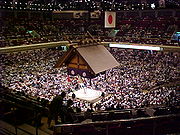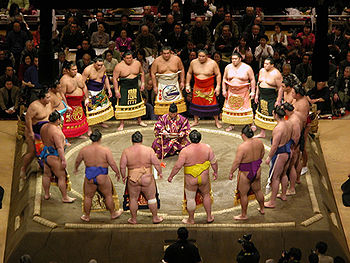
Honbasho
Encyclopedia
A is an official professional sumo
tournament. There are six held each year, a system established in 1958. Only honbasho results matter in determining promotion and relegation
for rikishi (sumo wrestlers).
 A literal translation of honbasho is "main (or real) tournament". This term is used to distinguish these tournaments from display basho which are held as part of sumo tours, between the six major tournaments. Such display tournaments may have prize money attached but a wrestler's performance has no effect on his ranking. This type of sumo is often called hana-sumo (lit. flower-sumo) as it is not taken as seriously by the wrestlers.
A literal translation of honbasho is "main (or real) tournament". This term is used to distinguish these tournaments from display basho which are held as part of sumo tours, between the six major tournaments. Such display tournaments may have prize money attached but a wrestler's performance has no effect on his ranking. This type of sumo is often called hana-sumo (lit. flower-sumo) as it is not taken as seriously by the wrestlers.
 Honbasho last for 15 days. Sumo wrestlers ranked in the top two divisions (makuuchi
Honbasho last for 15 days. Sumo wrestlers ranked in the top two divisions (makuuchi
and juryo) wrestle once each day, while those of the lower divisions wrestle seven times, approximately once every alternate day.
The first aim for most wrestlers is to achieve kachikoshi, or a majority of wins, and thus ensure a promotion for the next tournament. In addition for each division there is a championship prize (yūshō
) for the wrestler with the most wins at the end. A playoff on the final day is used to decide the winner in case of a tie.
Unless a playoff is required, two wrestlers will fight each other no more than once in a whole tournament. The bout schedule is set by a committee of sumo elders
a day or two in advance of a tournament day, and may be announced from the dohyō
the day prior by a senior gyōji
. Although there is no fixed method, for the first half of a tournament the top makuuchi
division will generally pair the top maegashira ranks against the sanyaku wrestlers, with the rest of maegashira fighting among ranks closer in strength. The schedule second half of the tournament will have mainly sanyaku fighting each other, with the remainder of the ranks determined by their win-loss records up to that point. One consideration is to minimize the necessity for a tiebreaker bout, particularly if a contender for the yūshō is lower-ranked and has thus far faced only other lower-ranked wrestlers.
Outside playoff bouts, neither wrestlers from the same heya
nor wrestlers related by blood are scheduled to fight each other.
For jūryō and below, the first half of a tournament will have wrestlers of similar rank competing against each other, while the second half will be determined by win-loss records.
A bye
is only possible if a wrestler has withdrawn due to injury after the bout schedule for a day is already set, in which case his opponent wins by forfeit. Otherwise, if a withdrawal results in an odd number of wrestlers in one division, the schedule is filled in by pairing a lower-ranked wrestler against a higher-ranked wrestler from the next-lower division.
The six honbasho are http://www.sumo.or.jp/eng/:
The March tournament in 2011 was cancelled due to the Sumo Association launching an investigation into allegations of match-fixing involving several sekitori
ranked wrestlers. This was the first cancellation of a honbasho since 1946, when the summer tournament was not held because of renovations to the Kokugikan following damage sustained in World War II. The May 2011 tournament went ahead, but was described by the Japan Sumo Association
as a "technical examination" tournament rather than a fully fledged honbasho, with tickets given away free in a lottery, and no prize money or trophies awarded.
Sumo
is a competitive full-contact sport where a wrestler attempts to force another wrestler out of a circular ring or to touch the ground with anything other than the soles of the feet. The sport originated in Japan, the only country where it is practiced professionally...
tournament. There are six held each year, a system established in 1958. Only honbasho results matter in determining promotion and relegation
Promotion and relegation
In many sports leagues around the world, promotion and relegation is a process that takes place at the end of each season. Through it, teams are transferred between divisions based on their performance that season...
for rikishi (sumo wrestlers).


Makuuchi
or is the top division of professional sumo. Its size is fixed at 42 wrestlers , ordered into five ranks according to their ability as defined by their performance in previous tournaments....
and juryo) wrestle once each day, while those of the lower divisions wrestle seven times, approximately once every alternate day.
The first aim for most wrestlers is to achieve kachikoshi, or a majority of wins, and thus ensure a promotion for the next tournament. In addition for each division there is a championship prize (yūshō
Yusho
A Yūshō is a tournament championship in sumo. It is awarded in each of the six annual honbasho or official tournaments, to the wrestler who wins the most number of bouts. Yūshō are awarded in all six professional sumo divisions...
) for the wrestler with the most wins at the end. A playoff on the final day is used to decide the winner in case of a tie.
Unless a playoff is required, two wrestlers will fight each other no more than once in a whole tournament. The bout schedule is set by a committee of sumo elders
Toshiyori
A toshiyori is a sumo elder of the Japan Sumo Association. Also known as oyakata, former wrestlers who reached a sufficiently high rank are the only people eligible...
a day or two in advance of a tournament day, and may be announced from the dohyō
Dohyo
thumb|A dohyōThe dohyō is the ring in which sumo wrestling bouts are held. A modern dohyo is a circle of rice-straw bales 4.55 meters in diameter, mounted on a square platform of clay 6.7m on a side, and 34 to 60 cm high. The surface is covered by sand.A new dohyō is built prior to each...
the day prior by a senior gyōji
Gyoji
A Gyōji is a referee in professional sumo wrestling in Japan.Gyōji usually enter the sumo world as teenagers and remain employees of the Sumo Association until they retire aged 65.-Responsibilities:...
. Although there is no fixed method, for the first half of a tournament the top makuuchi
Makuuchi
or is the top division of professional sumo. Its size is fixed at 42 wrestlers , ordered into five ranks according to their ability as defined by their performance in previous tournaments....
division will generally pair the top maegashira ranks against the sanyaku wrestlers, with the rest of maegashira fighting among ranks closer in strength. The schedule second half of the tournament will have mainly sanyaku fighting each other, with the remainder of the ranks determined by their win-loss records up to that point. One consideration is to minimize the necessity for a tiebreaker bout, particularly if a contender for the yūshō is lower-ranked and has thus far faced only other lower-ranked wrestlers.
Outside playoff bouts, neither wrestlers from the same heya
Heya
In sumo wrestling, a heya , usually translated into English as stable, is an organization of sumo wrestlers where they train and live. All wrestlers in professional sumo must belong to one. There are currently 49 heya , all but four of which belong to one of five ichimon...
nor wrestlers related by blood are scheduled to fight each other.
For jūryō and below, the first half of a tournament will have wrestlers of similar rank competing against each other, while the second half will be determined by win-loss records.
A bye
Bye (sports)
A bye, in sports and other competitive activities, most commonly refers to the practice of allowing a player or team to advance to the next round of a playoff tournament without playing...
is only possible if a wrestler has withdrawn due to injury after the bout schedule for a day is already set, in which case his opponent wins by forfeit. Otherwise, if a withdrawal results in an odd number of wrestlers in one division, the schedule is filled in by pairing a lower-ranked wrestler against a higher-ranked wrestler from the next-lower division.
The six honbasho are http://www.sumo.or.jp/eng/:
| Honbasho | Nickname | City | Venue | Opening Day |
|---|---|---|---|---|
| January | Hatsu (Opening) Basho | Tokyo Tokyo , ; officially , is one of the 47 prefectures of Japan. Tokyo is the capital of Japan, the center of the Greater Tokyo Area, and the largest metropolitan area of Japan. It is the seat of the Japanese government and the Imperial Palace, and the home of the Japanese Imperial Family... |
Ryōgoku Kokugikan Ryogoku Kokugikan , also known as Sumo Hall, is an indoor sporting arena located in the Ryōgoku neighborhood of Sumida, one of the 23 wards of Tokyo in Japan, next to the Edo-Tokyo Museum. It is the third building built in Tokyo associated with the name kokugikan. The current building was opened in 1985 and has a... |
1st or 2nd Sunday |
| March | Haru (Spring) Basho | Osaka Osaka is a city in the Kansai region of Japan's main island of Honshu, a designated city under the Local Autonomy Law, the capital city of Osaka Prefecture and also the biggest part of Keihanshin area, which is represented by three major cities of Japan, Kyoto, Osaka and Kobe... |
Osaka Prefectural Gymnasium | 2nd Sunday |
| May | Natsu (Summer) Basho | Tokyo | Ryōgoku Kokugikan | 2nd Sunday |
| July | Nagoya Basho | Nagoya | Aichi Prefectural Gymnasium Aichi Prefectural Gymnasium The is an all purpose gymnasium in Aichi, Japan, built in 1964. Located on the site of the secondary enclosure of Nagoya Castle, it is host to numerous concerts and events... |
1st or 2nd Sunday |
| September | Aki (Autumn/Fall) Basho | Tokyo | Ryōgoku Kokugikan | 2nd Sunday |
| November | Kyūshū Kyushu is the third largest island of Japan and most southwesterly of its four main islands. Its alternate ancient names include , , and . The historical regional name is referred to Kyushu and its surrounding islands.... Basho |
Fukuoka Fukuoka, Fukuoka is the capital city of Fukuoka Prefecture and is situated on the northern shore of the island of Kyushu in Japan.Voted number 14 in a 2010 poll of the World's Most Livable Cities, Fukuoka is praised for its green spaces in a metropolitan setting. It is the most populous city in Kyushu, followed by... |
Fukuoka Kokusai Center | 2nd Sunday |
The March tournament in 2011 was cancelled due to the Sumo Association launching an investigation into allegations of match-fixing involving several sekitori
Sekitori
A sekitori is a sumo wrestler who is ranked in one of the top two professional divisions: makuuchi and juryo.Currently there are 70 rikishi in these divisions...
ranked wrestlers. This was the first cancellation of a honbasho since 1946, when the summer tournament was not held because of renovations to the Kokugikan following damage sustained in World War II. The May 2011 tournament went ahead, but was described by the Japan Sumo Association
Japan Sumo Association
The is the body that operates and controls professional sumo wrestling in Japan under the jurisdiction of the Japanese Ministry of Education, Culture, Sports, Science and Technology. Rikishi , gyōji , tokoyama , and yobidashi , are all on the Association's payroll, but the organisation is run...
as a "technical examination" tournament rather than a fully fledged honbasho, with tickets given away free in a lottery, and no prize money or trophies awarded.
External links
- Honbasho schedule from the Japan Times.

